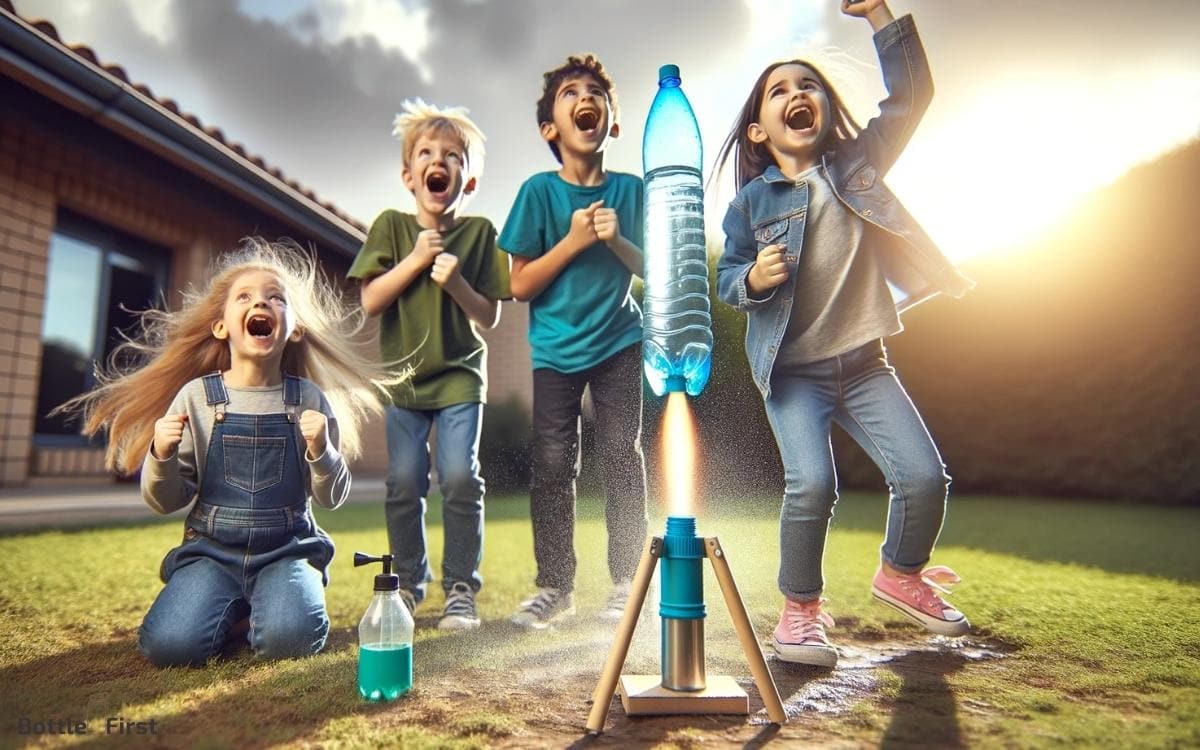How to Make a Water Bottle Rocket Go Higher? 4 Easy Steps!
To make a water bottle rocket go higher, enhance its aerodynamics, optimize the water-to-air ratio, use lightweight materials, and ensure proper pressure buildup. Employ a parachute for recovery to prevent damage on the descent.
Maximizing the altitude of a water bottle rocket involves several key factors:
- Aerodynamics: A streamlined design reduces air resistance, allowing the rocket to travel higher.
- Water-to-air ratio: Finding the ideal balance between water and compressed air is critical. Typically, a 1:2 ratio works well, with one-third of the bottle filled with water.
- Construction materials: Using lightweight materials for the body and fins of the rocket helps reduce weight, enabling it to reach higher altitudes.
- Pressure: The amount of pressure used to launch the rocket affects its height. Generally, the more pressure, the higher the rocket will go, up to a certain safety limit.
For example, if you modify a standard water bottle rocket by adding aerodynamic fins, experimenting with the water-to-air ratio, and using a bicycle pump to increase pressure, you should see an improvement in height.
- Aerodynamics: Streamlined body, fin design
- Water-to-air ratio: Approximately 1:2
- Materials: Lightweight plastic, cardboard fins
- Pressure: Optimal PSI for height increase
Achieving loftier flights with your water bottle rocket is a mix of science and trial and error. Take the time to test and tweak each variable for the ultimate skyward journey.
Key Takeaway
Step 1: Selecting the Right Bottle and Nose Cone
Selecting the appropriate bottle and nose cone is crucial for optimizing the performance of a water bottle rocket. When choosing a bottle, it is essential to select one that is both lightweight and durable.
A common choice is a 2-liter soda bottle, as it strikes a balance between weight and sturdiness. Additionally, the bottle should have a smooth and streamlined shape to minimize air resistance during flight.
As for the nose cone, it should also be aerodynamic to reduce drag. A well-designed nose cone will help the rocket cut through the air more efficiently, ultimately leading to higher altitudes.
When selecting materials for the nose cone, consider using lightweight yet rigid materials such as plastic or lightweight foam.
These considerations are vital for achieving optimal performance and maximizing the altitude reached by the water bottle rocket.
Step 2: Optimizing Water and Air Pressure
To achieve greater altitude, it is essential to carefully calibrate the water and air pressure within the rocket.
Optimizing water and air pressure in a water bottle rocket involves precision and attention to detail. The volume of water and air pressure directly impacts the thrust and launch trajectory of the rocket.
Increasing the water-to-air ratio can maximize the initial thrust, propelling the rocket to greater heights. However, excessive water can also lead to increased mass, potentially limiting the overall altitude.
Finding the optimal balance between water and air pressure is crucial for achieving the highest launch.
Experimentation and careful measurement of the water and air volume will allow for the identification of the ideal combination, ultimately leading to improved performance and greater altitude for the water bottle rocket.
Step 3: Enhancing Stability and Aerodynamics
Enhancing the stability and aerodynamics of the water bottle rocket requires careful consideration of the rocket’s design and fin configuration.
The rocket’s stability can be improved by ensuring that the center of gravity is located ahead of the center of pressure.
Additionally, the rocket’s aerodynamics can be enhanced by using streamlined shapes and reducing drag.
The table below outlines key considerations for enhancing stability and aerodynamics:
| Aspect | Consideration | Impact |
|---|---|---|
| Center of gravity | Position it ahead of the center of pressure | Ensures stable flight |
| Fin configuration | Use symmetric, aerodynamic fins | Reduces drag and improves stability |
| Streamlined design | Minimize protrusions and use smooth surfaces | Reduces air resistance |
Step 4: Fine-Tuning the Launch Angle
Fine-tuning the launch angle of the water bottle rocket is crucial for optimizing its flight trajectory and further improving stability and aerodynamics.
Achieving the perfect launch angle can significantly impact the rocket’s altitude and overall performance.
To evoke an emotional response in the audience, consider the following:
- Imagine the thrill of watching your water bottle rocket soar to new heights with a carefully calibrated launch angle.
- The satisfaction of witnessing your meticulous adjustments results in a breathtaking ascent.
- The anticipation and excitement as you prepare to unleash the full potential of your water bottle rocket.
Experimenting With Additional Thrust Techniques
When considering the optimization of a water bottle rocket’s performance, experimenting with additional thrust techniques becomes a pivotal factor in achieving higher altitudes and improved flight dynamics.
By implementing various thrust techniques, the rocket’s propulsion can be enhanced, resulting in greater velocity and ultimately reaching higher altitudes.
Below is a table outlining different thrust techniques and their potential impact on the rocket’s performance:
| Thrust Technique | Impact on Performance |
|---|---|
| Water-Only Propulsion | Efficient use of water for propulsion, moderate altitude gain |
| Water and Air Mixture | Increased thrust, higher initial acceleration, and improved altitude |
| Compressed Air Only | Rapid initial acceleration, potentially the highest altitude gain |
Experimenting with these additional thrust techniques allows for innovation and optimization of the water bottle rocket’s performance, pushing the boundaries of what is achievable.
Conclusion
In conclusion, by carefully selecting the right bottle and nose cone, optimizing water and air pressure, enhancing stability and aerodynamics, fine-tuning the launch angle, and experimenting with additional thrust techniques, you can increase the height of a water bottle rocket.
By following these technical and methodical steps, you can achieve greater altitude and performance, allowing for a more thrilling and successful launch.
Mastering these techniques will lead to a more impressive and enjoyable water bottle rocket experience.

